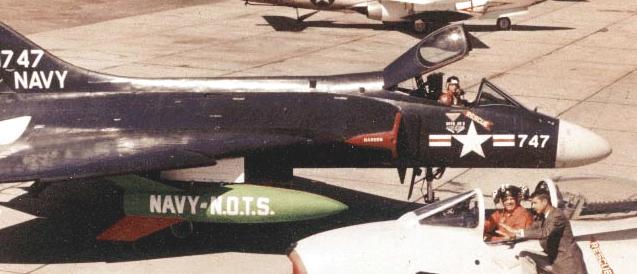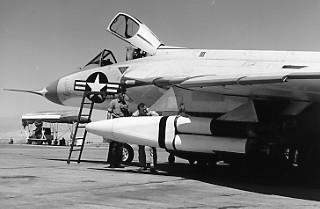NOTS NOTS-EV-1 Pilot (NOTSNIK)
In early 1958, engineers at the Naval Ordnance Test Station (NOTS) at China Lake proposed to build a very small multi-stage air-launched satellite launch vehicle using existing solid-propellant rockets. To obtain funding, it was officially proposed to orbit a small instrumented satellite to make measurements during high-altitude nuclear tests (Project Argus) planned for August 1958. Development was approved, and the program was officially named Project Pilot. However, it is better known as NOTSNIK, a combination of "NOTS" and "Sputnik". The vehicle itself was also designated NOTS-EV-1.
 |
| Photo: U.S. Navy |
| NOTS-EV-1 test shape |
The NOTS-EV-1 Pilot rocket was a five-stage vehicle, but NOTSNIK is sometimes called a six-stage system, when the launching aircraft is counted as the first stage. All Pilot launches used a modified F4D-1 Skyray fighter, which carried the NOTS-EV-1 on an underwing pylon. The rocket was released in a 50° zoom climb at a speed of 740 km/h (460 mph) at an altitude of 12500 m (41000 ft). The first and second stages of the rocket used a common airframe, and consisted of two HOTROC solid-fueled motors each, mounted diagonally opposed in a two-by-two pattern. Three seconds after release, the first stage fired for about 5 seconds, followed by 12 seconds of coasting and the firing of the second stage. At about 80 km (50 miles) altitude, the first/second stage structure was jettisoned, followed by a 36 second burn of the ABL X-241 third stage. The fourth stage was a small NOTS-100 solid rocket, which burned for 5.7 seconds and placed the payload into an "orbit" with an extremely low perigee (about 2400 x 60 km (1500 x 37 miles)). The perigee was raised to a safe 2250 km (1400 miles) by the fifth stage, a tiny motor integrated with the payload. The latter had a diameter of 20 cm (8 in), weighed only 1.05 kg (2.3 lb) and had a single instrument, a very primitive infrared line-scanning device to make crude IR images of the ground. This device effectively meant that the NOTSNIK satellite could be seen as a space-based surveillance platform, and therefore the whole effort was top secret at that time.
 |
 | |
| Photo: U.S. Navy (via Gary Verver collection) | Photo: U.S. Navy (via Gunter Krebs) | |
| Pilot (NOTS-EV-1) | ||
After two failed ground launches of the first/second stage HOTROC motors in early July 1958, the first air-launch of a Pilot vehicle was attempted on 25 July. The launch was successful as long as the vehicle was visually tracked, but there was no confirmed radio contact afterwards. During August 1958, five additional NOTSNIK launches were attempted, but all except one ended very early after release of the rocket because of failures of a rocket motor and/or the vehicle's structure. On that second possibly successful flight, on 22 August, again no definite radio contact could be established with the possibly orbiting payload. Although it is reported that ground stations received a few very weak signals, which could have come from the satellite, it remains very doubtful whether the payload did actually reach the planned orbit.
Further Pilot flights were cancelled after August 1958, but the Pilot/NOTSNIK work was eventually continued in the Caleb follow-on project.
Specifications
Note: Data given by several sources show slight variations. Figures given below may therefore be inaccurate!
Data for Pilot (NOTS-EV-1):
| Length | 4.38 m (14 ft 4.5 in) |
| Finspan | 1.65 m (5 ft 5 in) |
| Diameter | 76.2 cm (30 in) |
| Weight | 950 kg (2100 lb) |
| Speed | (orbital) |
| Altitude | 2400 km (1500 miles) |
| Propulsion | 1st stage: 2x HOTROC solid-fueled rocket; 126.4 kN (28400 lb) for 4.86 s 2nd stage: 2x HOTROC solid-fueled rocket; 126.4 kN (28400 lb) for 4.86 s 3rd stage: ABL X-241 solid-fueled rocket; 12.1 kN (2720 lb) for 36 s 4th stage: NOTS-100 solid-fueled rocket; 5.14 kN (1155 lb) for 5.7 s 5th stage: NOTS solid-fueled rocket; 765 N (172 lb) for 1 s |
Main Sources
[1] Andrew J. LePage: "NOTSNIK: The Navy's Secret Satellite Program", article in "Spaceviews", July 1998 (available online
here)
[2] Roger D. Launius, Dennis R. Jenkins (eds.): "To Reach the High Frontier: A History of U.S. Launch Vehicles",
University Press of Kentucky, 2002
[3] Gunter's Space Page
Back to Directory of U.S. Military Rockets and Missiles, Appendix 4
Last Updated: 17 October 2003